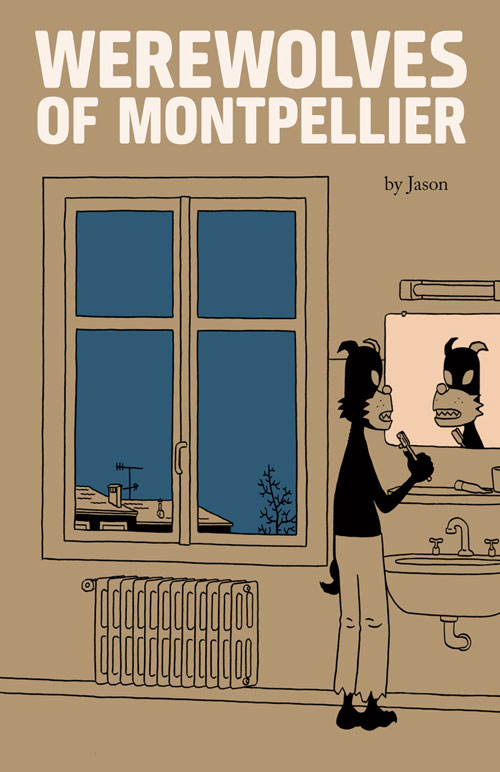 There are two stories that Jason is telling in Werewolves of Montpellier. In the first story, the thief Sven prowls the rooftops of Montpellier wearing a werewolf mask. The mask is to surprise the people in case he’s caught, hopefully frightening them long enough for him to make his getaway. When Audrey, his confidant, asks him why he robs people, he tells her that he doesn’t trust other people; they’ve let him down in the past. It’s not a good answer but it’s his answer. When he’s photographed wearing the werewolves’ mask, the real werewolves of Montpellier want him punished. Their existence is supposed to be a secret and they can’t have pictures of werewolves showing up in the newspapers, even if those pictures are not real.
There are two stories that Jason is telling in Werewolves of Montpellier. In the first story, the thief Sven prowls the rooftops of Montpellier wearing a werewolf mask. The mask is to surprise the people in case he’s caught, hopefully frightening them long enough for him to make his getaway. When Audrey, his confidant, asks him why he robs people, he tells her that he doesn’t trust other people; they’ve let him down in the past. It’s not a good answer but it’s his answer. When he’s photographed wearing the werewolves’ mask, the real werewolves of Montpellier want him punished. Their existence is supposed to be a secret and they can’t have pictures of werewolves showing up in the newspapers, even if those pictures are not real.
Jason’s second story is a about Sven, an artist who spends his days sketching the architecture of Montpellier or playing chess and talking about the best ways the best ways to appreciate women. His nights are usually spent with Audrey, his next door neighbor and best friend. She’s always trying to set him up with her friends, throwing parties just so he can meet girls. He’s also quite in love with her but can never get the courage to say anything about it.
Those two stories are the two halves of Werewolves of Montpellier as Jason tells a subtle, heart-breaking story that has its own share of adventure. Or is he telling an adventure story that has some romance in it? I’m never quite sure with his books. It’s hard to classify what kind of story this book is because he tries to balance out the different aspects of the book. The balancing act here doesn’t work as well as it has in the past, most recently with I Killed Adolph Hitler or even in The Last Musketeer. In those stories, there’s almost a perfect equilibrium between the different parts of the story, between the love stories and the adventures. With Werewolves of Montpellier, the werewolf story often disappears into the background. He still has that balance but it’s not as strong and equal as it has been in his other stories.
Jason never lets you get close to his characters. In this book, like in most his other books, he never easily lets you into the story. He draws every panel from practically the same viewpoint. Once he establishes a scene, he rarely shifts to give you another view of the room characters are in or follows a character as they walk out of a panel. He never moves any closer or farther away from his characters. Sven and all of the other characters remain visually constant to us, never changing. They never get closer or move away. Jason keeps his images very 2-dimensional and has no use for any kind of dramatic depth to his drawings. Add in the fact that all of Jason’s characters are animal-like men and women- cats, dogs and birds- and it almost feels like Jason does everything he can visually to hold his readers at a distance and to never let them fully into his story.
Just as he physically never lets you get close to his characters, he sets up emotional barriers as well. His animal-like creatures are almost all the same, from book to book. Compare Sven in this book to almost any of his leading characters and physically they’re the same, almost right down to the deadpan expressions. Jason lets his characters actions and words speak for them more than their appearance. The ways that Audrey softly supports Sven’s nocturnal actions or shares an umbrella with him on a rainy day defines who she is so much more than her physical appearance. Jason wants us to work to get to know these characters. He doesn’t make it easy and over exaggerate anything. He’s a stingy storyteller on the face of the page but he conveys so much about his characters in every panel if you’re willing to look for it.
Even Jason’s stories feel like a contradiction as the cartoonist never wants to tell the reader what the story really is. Werewolves of Montpellier is one third To Catch a Thief, one third The Wolfman and a final third Breakfast at Tiffany’s, complete with its own Audrey Hepburn stand-in. There are elements of all of these movies in Jason’s story, as Sven’s story crosses over into many different roles but Jason here is going for a fusion to create something new, something subtly wild and vibrant.
”Vibrant” is an odd word to use with Jason’s storytelling. There’s certainly not too much bombastic or energetic in Jason’s storytelling. Actually his pacing has a measured quietness to it as he presents the various parts of his story in a very matter-of-fact manner. There’s no different in the reality of Sven’s relationship with Audrey (it doesn’t exist the way Sven wants it to) and the reality of werewolves running around a French town (they do exist much to Sven’s surprise.) Jason approaches each aspect of his story with the same calm voice, trying to make each part of the story as real as any other. The werewolves are just as real as Audrey and Sven.




Comments